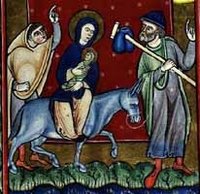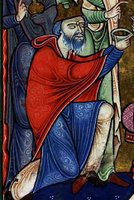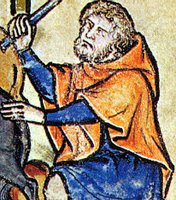This continues from the previous post on shepherds and peasants.
I guess i should have explained more fully in the last part that I'm showing pictures of hoods as well as hooded cloaks, because I see so little differentiation between the two. If you can draw up a simple rule to tell me when a hood with a long bottom becomes a short hooded cloak, please tell me. And besides, hoods may provide valuable construction clues about hooded cloaks, besides being interesting in themselves. While I'm adding examples, it seemed sensible to add hooded tunics.
Oh, and I'm putting in some 13th Century examples too because I think the style may not have changed much and it's worth considering them (with due care for stylistic changes) even for 12th C evidence.
So, some common people in cloaks: Bibliothèque nationale de France Division occidentale Latin 14771(bible at pent lv glos. ) 12thC France
Bibliothèque nationale de France Division occidentale Latin 14771(bible at pent lv glos. ) 12thC France
Fol 1. Moïse et le taureau du sacrifice
- man in centre (behind two other men) has a very pointy dark red hood
- There are traces of red lower in the pictures, so this could be a cloak or tunic, but I can't be sure.
 Chartres Cathedral carving
Chartres Cathedral carving13th C France
February – Man warming himself
- Note this is 13th C
- Might just be a rectangular cloak draped over the head and fastened at the neck
- notice how he wears what is probably a coif under it.

 Belvior Castle manuscript (Rutland Psalter)
Belvior Castle manuscript (Rutland Psalter)Mid 13th C English, Salisbury
- Note this is 13th C
- Both hoods have very pointy ends, drawn out a bit like a short liripipe
- both hoods have a clear seam down the top of the head
 British Library MS Cotton Nero C. IV (Winchester Psalter)
British Library MS Cotton Nero C. IV (Winchester Psalter)Winchester [Priory of St Swithun or Hyde Abbey], England; between 1121 and 1161
Folio21Betrayal and Flagellation. Spectator pictured with flail and lamp
- A cloak with hood. Can't tell if it is fastened at the front or pullover style
- This hood is strangely vertical
- The hood is much looser at the neck than other examples
 The Hague, KB, 76 F 13 (Fecamp Psalter ) Normandy (Fécamp?); c. 1180
The Hague, KB, 76 F 13 (Fecamp Psalter ) Normandy (Fécamp?); c. 1180Fol. 2v February: a man warming himself at a fire
- cloak with hood. No front opening
- very pointy hood. Points upward from the head rather than backwards
- There is a slight notch at the front neck. I think this might be a keyhole neckline.
Another group that used cloaks were travellers - the chape was the medieval raincoat.
 Morgan Library M710 (Abbot Berthold Missal)
Morgan Library M710 (Abbot Berthold Missal)Germany 1200-1252
- Note 13thC
- This second traveller may be the abbot (hence wearing a cowl (ecclesiastical chape) rather than secular chape
- Notice how his has sleeves

 Thott 143 2º: (The Copenhagen Psalter )
Thott 143 2º: (The Copenhagen Psalter )England, 1175-1200.
Fol 11r. The Adoration of the Magi, Fol.12r. The flight into Egypt
- The magi king wears a cloak that has a hood. It's possible that this is a cunningly folded fold in a rectangular cloak, but the flow of the rest of the cloak is sufficiently similar to other cloaks on this page that I'd say it's based on a circle
- Note the wonderfully rich (expensive ) colour of his cloak.
- In the second image, the traveller on the left wears a hooded cloak with an exaggerated rounded point. It's longer at the back than front.
- His cloak sits with a point at the bottom of the hood neck opening. That's a rather particular set of stresses, and not just a straight round hole.
- Mary could be wearing a cloak, but i think it's more likely she wears a wrap - an extra large veil type thing
- The third figure (Jospeh I assume) wears a cloak with no visible hood -although one may be hidden, it's more likely he is depicted in a mantle

 Morgan Library ms m.638 (Maciejowski Bible), Paris 1244-1254AD
Morgan Library ms m.638 (Maciejowski Bible), Paris 1244-1254ADleaf 10. The Gibeonites sue for peace with Joshua and the Israelites.
fol 45r. David flees Jerusalem, His steward Ziba (pictured), goads mules with supplies
- Note 13th C
- The first few Gibeonites wear (rather worn) hooded tunics with attached hoods and short sleeves with slits underneath so they can be worn as surcoats
- The man riding a horse wears a hood like the ones we saw in the depiction of shepherds from the same manuscript
- The last boy wears a hood which is different - it is tight at the neck and doesn't extend to the shoulders
- second picture depicts a hooded cloak with no front opening
- I think I can see a fine line running along the top edge of the hood, a seam?
- slightly longer at back
 Venice, Marciana Library Psalterium cum Cantis, 13th Century
Venice, Marciana Library Psalterium cum Cantis, 13th CenturySt Eustice
- Note 13thC
- Sort of a cross between tunic and cloak.
- The sleeve are much longer than his arms, and quite wide the ends would hang over the hands, keeping them warm and dry.
- Slits under the arms allow him to wear it as a sleeveless surcoat
- there is a line at the front of the neck - a line of stitching or a fastened keyhole?
- The hood is tightly fitted and pointy along the top edge.
Conclusions
- Even high ranking nobles (eg magi) are depicted wearing mantles occasionally when travelling.
- There is plenty of evidence for a seam along the top edge of the hood
- Some of these hoods appear to open a little ways down the neck at the front, possibly a keyhole or some other device to allow the head through more easily without making the hole hood larger
- Two common styles of hood seem to be one where the point points to the top seam, (end of point tends to sit higher than the top of the head) and another that points downwards with a softer more rounded and generally longer point.
- Cloaks sometimes have sleeves.

No comments:
Post a Comment